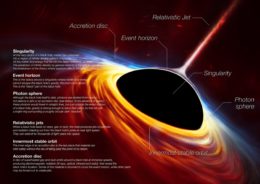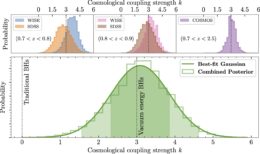What do black holes have to do with dark energy, the subtle pressure that accelerates the expansion of our universe? New research suggests that the two may be inextricably linked, potentially solving the long-standing mystery of the nature of dark energy.
Multiple Black Hole Models

Illustration of a traditional black hole model with important components of the model labeled. Click to enlarge. [ESO; CC BY 4.0]
However, this common black hole model is in tension with the overall expansion of the universe, leading some scientists to propose alternative models. In one such model, black holes do not contain a singularity, but are instead filled with vacuum energy. These vacuum-energy black holes are intriguing because their growth is coupled to the expansion of the universe: as the universe expands, these black holes gain mass.
Do Black Holes Gain Mass as the Universe Expands?
In a research article published today, Duncan Farrah (University of Hawaiʻi) and collaborators tested this black hole model by studying the growth of supermassive black holes over billions of years. The team studied elliptical galaxies since these galaxies’ central supermassive black holes are unlikely to grow much by other means, such as by consuming nearby stars and gas.

The probability of different coupling strengths as derived from several different data sets. The results are incompatible with traditional black holes (BHs), which are not coupled to the expansion of the universe. [Farrah et al. 2023]
Dark Energy, Illuminated

Star formation rate density (SFRD) as a function of redshift. The green shaded area shows the possible star formation rates that will yield the density of black holes necessary to produce the observed dark energy density. The solid lines show the model results for different initial mass distributions of newborn stars. Click to enlarge. [Farrah et al. 2023]
Farrah and collaborators performed additional modeling showing that the expected population of vacuum-energy black holes can account for the density of dark energy previously measured by the Planck satellite — so not only do vacuum-energy black holes generate dark energy, they generate the same amount of dark energy we’ve measured! Hopefully, the next few months to years will bring more research on this topic, expanding our understanding of the fundamental physics of our universe.
Citation
“Observational Evidence for Cosmological Coupling of Black Holes and Its Implications for an Astrophysical Source of Dark Energy,” Duncan Farrah et al 2023 ApJL 944 L31. doi:10.3847/2041-8213/acb704

